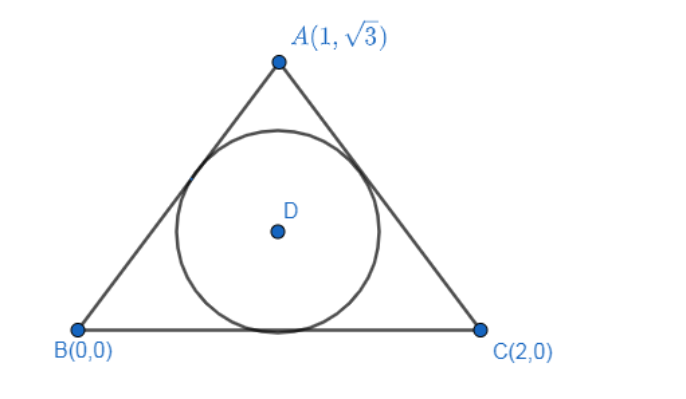
The incentre of the triangle with vertices \[\left( 1,\sqrt{3} \right),\left( 0,0 \right)\] and \[\left( 2,0 \right)\]is
\[\left( 1,\dfrac{\sqrt{3}}{2} \right)\]
\[\left( \dfrac{2}{3},\dfrac{1}{\sqrt{3}} \right)\]
\[\left( \dfrac{2}{3},\dfrac{\sqrt{3}}{2} \right)\]
\[\left( 1,\dfrac{1}{\sqrt{3}} \right)\]
.
Answer
504.6k+ views
Hint:To solve the question, we have to analyse the type of the given triangle which will result in the given triangle being an equilateral triangle. To solve further, apply the properties of the equilateral triangle, which states that the centroid and incentre of equilateral triangle coincide. To solve further, calculate the centroid of the given triangle to find the value of the incentre.
Complete Step-by-step answer:
Let the given triangle be \[\Delta ABC\]with vertices A, B, C as\[\left( 1,\sqrt{3} \right),\left( 0,0 \right)\left( 2,0 \right)\] respectively.
We know the formula for the distance between two points \[\left( {{x}_{1}},{{y}_{1}} \right),\left( {{x}_{2}},{{y}_{2}} \right)\]is given by \[\sqrt{{{\left( {{x}_{1}}-{{x}_{2}} \right)}^{2}}+{{\left( {{y}_{1}}-{{y}_{2}} \right)}^{2}}}\]
Thus, by applying the formula for the given values we get
The length of side AB =\[\sqrt{{{\left( 1-0 \right)}^{2}}+{{\left( \sqrt{3}-0 \right)}^{2}}}=\sqrt{{{1}^{2}}+{{\left( \sqrt{3} \right)}^{2}}}=\sqrt{1+3}=\sqrt{4}=2\]
\[\Rightarrow \]AB = 2 units.
The length of side BC =\[\sqrt{{{\left( 0-2 \right)}^{2}}+{{\left( 0-0 \right)}^{2}}}=\sqrt{{{\left( -2 \right)}^{2}}+{{\left( 0 \right)}^{2}}}=\sqrt{4+0}=\sqrt{4}=2\]
\[\Rightarrow \] BC = 2 units.
The length of side CA =\[\sqrt{{{\left( 1-2 \right)}^{2}}+{{\left( \sqrt{3}-0 \right)}^{2}}}=\sqrt{{{\left( -1 \right)}^{2}}+{{\left( \sqrt{3} \right)}^{2}}}=\sqrt{1+3}=\sqrt{4}=2\]
\[\Rightarrow \] CA = 2 units.
Thus, AB = BC = CA
We know that a triangle is an equilateral triangle when all the three sides of the triangle are equal.
Thus, we conclude that \[\Delta ABC\]is an equilateral triangle, as shown below:

Here D is the centroid or incentre of the given triangle.
We know that the formula for centroid of a triangle is equal to
\[\left( \dfrac{{{x}_{1}}+{{x}_{2}}+{{x}_{3}}}{3},\dfrac{{{y}_{1}}+{{y}_{2}}+{{y}_{3}}}{3} \right)\] where \[\left( {{x}_{1}},{{y}_{1}} \right),\left( {{x}_{2}},{{y}_{2}} \right)\left( {{x}_{3}},{{y}_{3}} \right)\] are vertices of a triangle.
By substituting the values in the above formula, we get
The centroid of \[\Delta ABC\]is equal to \[\left( \dfrac{1+0+2}{3},\dfrac{\sqrt{3}+0+0}{3} \right)=\left( \dfrac{3}{3},\dfrac{\sqrt{3}}{3} \right)=\left( 1,\dfrac{\sqrt{3}}{{{\left( \sqrt{3} \right)}^{2}}} \right)=\left( 1,\dfrac{1}{\sqrt{3}} \right)\]
Thus, the centroid of \[\Delta ABC\]is equal to \[\left( 1,\dfrac{1}{\sqrt{3}} \right)\]
We know that in an equilateral triangle centroid and incentre of the triangle coincidence.
Thus, the incentre of the triangle is equal to \[\left( 1,\dfrac{1}{\sqrt{3}} \right)\]
Hence, option (d) is the right choice.
Note:The possibility of mistake can be not analysing the type of the given triangle which eases the procedure of solving. The other possibility of mistake can be not applying the properties of the analysed type of triangle. The alternative way of solving the question is by using the direct formula for incentre which is equal to \[\left( \dfrac{a{{x}_{1}}+b{{x}_{2}}+c{{x}_{3}}}{a+b+c},\dfrac{a{{y}_{1}}+b{{y}_{2}}+c{{y}_{3}}}{a+b+c} \right)\]where a, b, c are the side lengths and \[\left( {{x}_{1}},{{y}_{1}} \right),\left( {{x}_{2}},{{y}_{2}} \right)\left( {{x}_{3}},{{y}_{3}} \right)\] are vertices of the given triangle.
Complete Step-by-step answer:
Let the given triangle be \[\Delta ABC\]with vertices A, B, C as\[\left( 1,\sqrt{3} \right),\left( 0,0 \right)\left( 2,0 \right)\] respectively.
We know the formula for the distance between two points \[\left( {{x}_{1}},{{y}_{1}} \right),\left( {{x}_{2}},{{y}_{2}} \right)\]is given by \[\sqrt{{{\left( {{x}_{1}}-{{x}_{2}} \right)}^{2}}+{{\left( {{y}_{1}}-{{y}_{2}} \right)}^{2}}}\]
Thus, by applying the formula for the given values we get
The length of side AB =\[\sqrt{{{\left( 1-0 \right)}^{2}}+{{\left( \sqrt{3}-0 \right)}^{2}}}=\sqrt{{{1}^{2}}+{{\left( \sqrt{3} \right)}^{2}}}=\sqrt{1+3}=\sqrt{4}=2\]
\[\Rightarrow \]AB = 2 units.
The length of side BC =\[\sqrt{{{\left( 0-2 \right)}^{2}}+{{\left( 0-0 \right)}^{2}}}=\sqrt{{{\left( -2 \right)}^{2}}+{{\left( 0 \right)}^{2}}}=\sqrt{4+0}=\sqrt{4}=2\]
\[\Rightarrow \] BC = 2 units.
The length of side CA =\[\sqrt{{{\left( 1-2 \right)}^{2}}+{{\left( \sqrt{3}-0 \right)}^{2}}}=\sqrt{{{\left( -1 \right)}^{2}}+{{\left( \sqrt{3} \right)}^{2}}}=\sqrt{1+3}=\sqrt{4}=2\]
\[\Rightarrow \] CA = 2 units.
Thus, AB = BC = CA
We know that a triangle is an equilateral triangle when all the three sides of the triangle are equal.
Thus, we conclude that \[\Delta ABC\]is an equilateral triangle, as shown below:

Here D is the centroid or incentre of the given triangle.
We know that the formula for centroid of a triangle is equal to
\[\left( \dfrac{{{x}_{1}}+{{x}_{2}}+{{x}_{3}}}{3},\dfrac{{{y}_{1}}+{{y}_{2}}+{{y}_{3}}}{3} \right)\] where \[\left( {{x}_{1}},{{y}_{1}} \right),\left( {{x}_{2}},{{y}_{2}} \right)\left( {{x}_{3}},{{y}_{3}} \right)\] are vertices of a triangle.
By substituting the values in the above formula, we get
The centroid of \[\Delta ABC\]is equal to \[\left( \dfrac{1+0+2}{3},\dfrac{\sqrt{3}+0+0}{3} \right)=\left( \dfrac{3}{3},\dfrac{\sqrt{3}}{3} \right)=\left( 1,\dfrac{\sqrt{3}}{{{\left( \sqrt{3} \right)}^{2}}} \right)=\left( 1,\dfrac{1}{\sqrt{3}} \right)\]
Thus, the centroid of \[\Delta ABC\]is equal to \[\left( 1,\dfrac{1}{\sqrt{3}} \right)\]
We know that in an equilateral triangle centroid and incentre of the triangle coincidence.
Thus, the incentre of the triangle is equal to \[\left( 1,\dfrac{1}{\sqrt{3}} \right)\]
Hence, option (d) is the right choice.
Note:The possibility of mistake can be not analysing the type of the given triangle which eases the procedure of solving. The other possibility of mistake can be not applying the properties of the analysed type of triangle. The alternative way of solving the question is by using the direct formula for incentre which is equal to \[\left( \dfrac{a{{x}_{1}}+b{{x}_{2}}+c{{x}_{3}}}{a+b+c},\dfrac{a{{y}_{1}}+b{{y}_{2}}+c{{y}_{3}}}{a+b+c} \right)\]where a, b, c are the side lengths and \[\left( {{x}_{1}},{{y}_{1}} \right),\left( {{x}_{2}},{{y}_{2}} \right)\left( {{x}_{3}},{{y}_{3}} \right)\] are vertices of the given triangle.
Recently Updated Pages
The correct geometry and hybridization for XeF4 are class 11 chemistry CBSE

Water softening by Clarks process uses ACalcium bicarbonate class 11 chemistry CBSE

With reference to graphite and diamond which of the class 11 chemistry CBSE

A certain household has consumed 250 units of energy class 11 physics CBSE

The lightest metal known is A beryllium B lithium C class 11 chemistry CBSE

What is the formula mass of the iodine molecule class 11 chemistry CBSE

Trending doubts
10 examples of friction in our daily life

One Metric ton is equal to kg A 10000 B 1000 C 100 class 11 physics CBSE

Difference Between Prokaryotic Cells and Eukaryotic Cells

State and prove Bernoullis theorem class 11 physics CBSE

What organs are located on the left side of your body class 11 biology CBSE

How many valence electrons does nitrogen have class 11 chemistry CBSE




